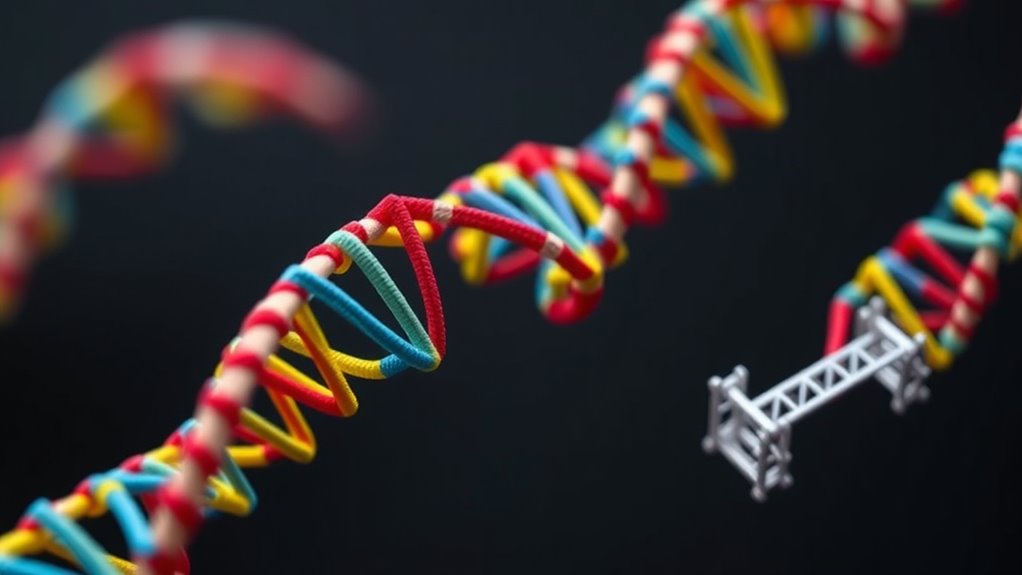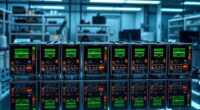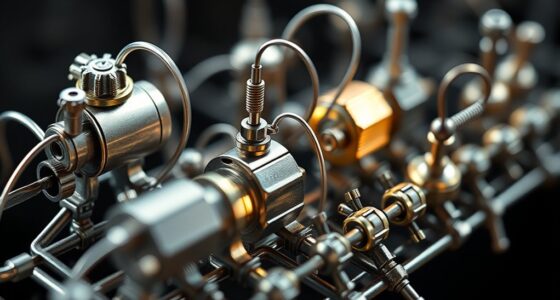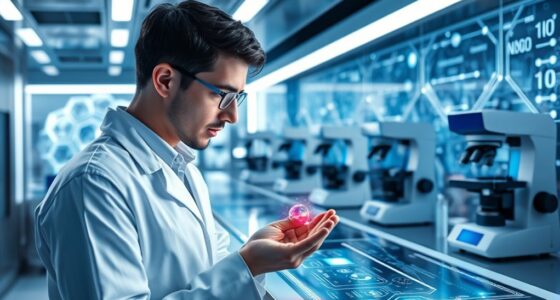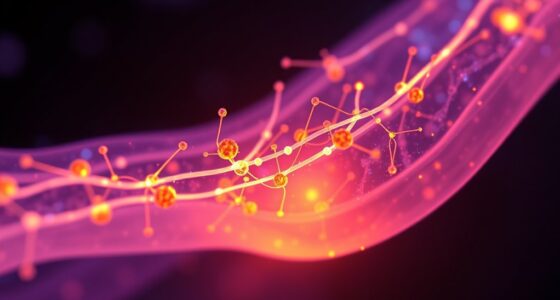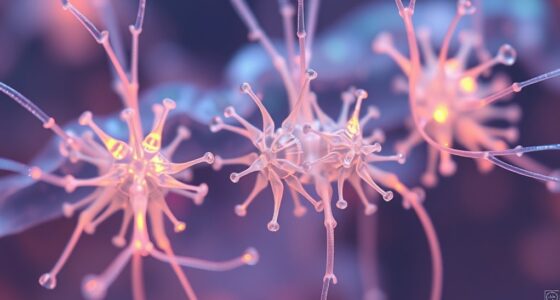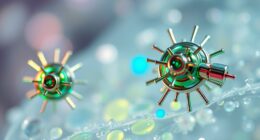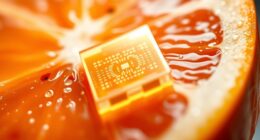To build nanomachines with DNA origami tiles, you design long DNA strands folded into specific shapes using short staple strands that hybridize precisely. This technique allows you to create highly stable, customizable nanostructures with integrated functional elements like binding sites or catalytic regions. Controlling assembly conditions and stabilization methods guarantees accurate construction. If you keep exploring, you’ll discover how these tiny machines can revolutionize medicine, electronics, and synthetic biology.
Key Takeaways
- Design DNA origami tiles with specific shapes and functional sites for targeted nanomachine assembly.
- Utilize precise hybridization and thermal annealing to reliably assemble tiles into complex nanostructures.
- Incorporate molecular recognition elements and catalytic motifs to enable task-specific functions.
- Reinforce and stabilize nanostructures through crosslinking or binding staples for durability.
- Integrate multiple tiles into larger, reconfigurable systems for dynamic nanomachines and environmental sensing.
Understanding the Principles of DNA Origami
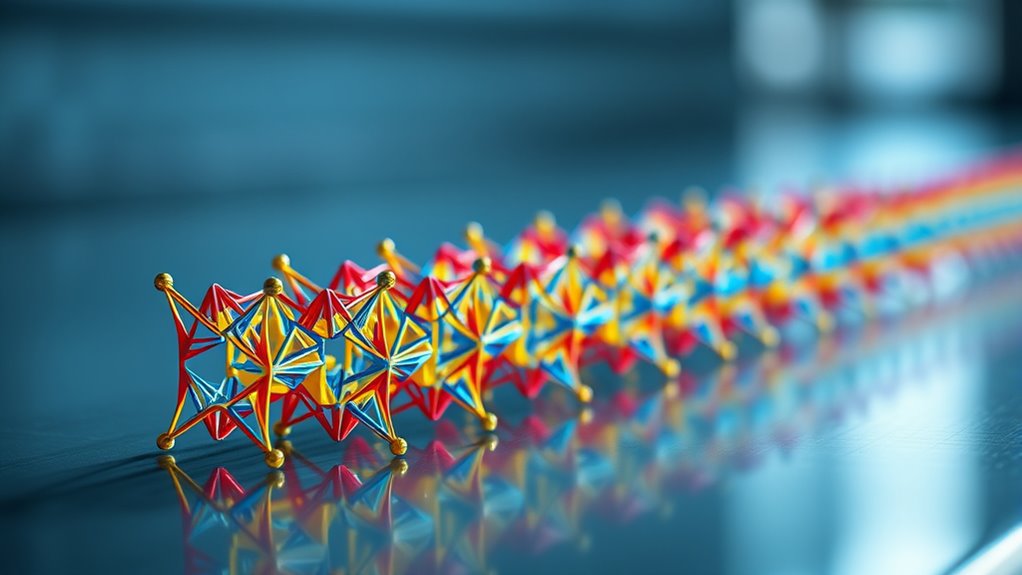
To understand the principles of DNA origami, you need to recognize how a long single-stranded DNA molecule can be folded into precise shapes using short staple strands. This process relies on dna hybridization, where complementary sequences bind specifically, guiding the folding. The long strand acts as a genetic scaffolding, providing a framework for the design. By designing staple strands that attach at specific locations, you control how the DNA folds into complex, nanoscale structures. This precise hybridization allows you to create stable, custom shapes with high accuracy. Basically, you’re harnessing natural DNA pairing to engineer intricate nanostructures, making DNA origami a powerful tool for building nanoscale machines and devices. Understanding hybridization techniques enhances your ability to design and manipulate these nanostructures more effectively.
Designing DNA Nanostructures for Specific Functions
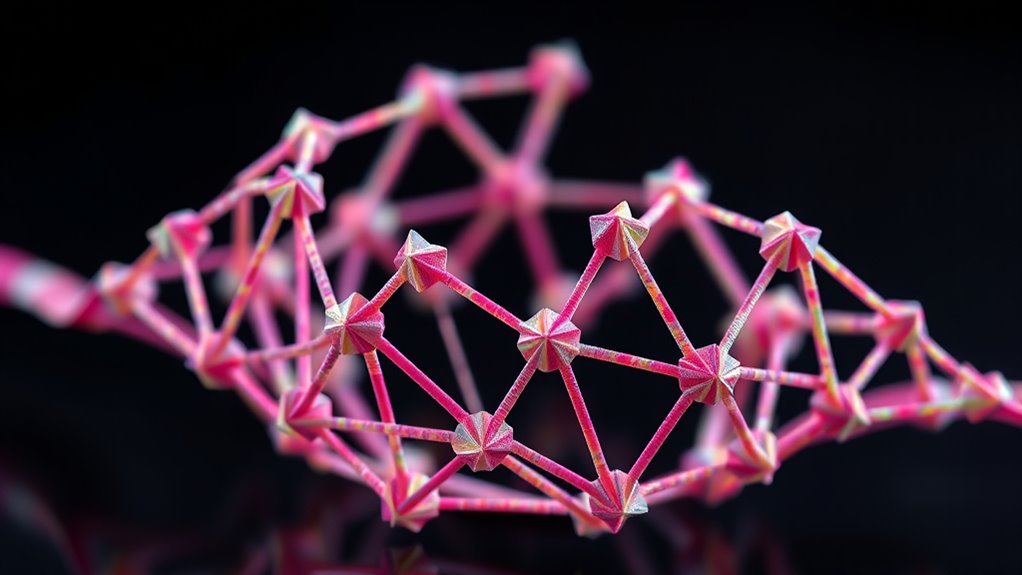
You can design DNA nanostructures by choosing specific shapes that meet your target functions. Implementing effective strategies for integrating functionalities guarantees your structures perform as intended. Customizing DNA tiles allows you to fine-tune the assembly process for precise, application-specific nanomachines. Additionally, designing with space and organization in mind can improve the efficiency and reliability of your nanostructures.
Targeted Shape Assembly
Targeted shape assembly is a crucial aspect of designing DNA nanostructures that perform specific functions. By controlling how DNA tiles come together, you can create precise shapes that enable molecular motors to operate or facilitate dna computing. You’ll choose specific binding sites and design sequences to guarantee only desired interactions occur, guiding the assembly process with high accuracy. This targeted approach allows you to craft complex, functional nanostructures tailored for tasks like cargo transport or logic operations. The ability to direct shape formation enhances the performance and reliability of these nanodevices. Ultimately, mastering targeted shape assembly empowers you to develop sophisticated systems that seamlessly integrate form and function at the nanoscale.
Functionality Integration Strategies
Integrating specific functions into DNA nanostructures requires careful design strategies that embed functional elements directly into the architecture. You can incorporate molecular recognition sites to enable precise interactions with target molecules, enhancing selectivity and responsiveness. By strategically positioning aptamers or binding domains, you improve recognition capabilities within the nanomachine. Additionally, enzyme catalysis functions can be integrated by attaching enzyme molecules or catalytic motifs at specific sites, allowing the structure to facilitate biochemical reactions. This approach enables your DNA origami to act as a nanoscale reactor or sensor. Combining molecular recognition with enzyme catalysis creates multifunctional platforms capable of targeted detection, signal transduction, or controlled biochemical activity. Ultimately, these strategies allow you to tailor DNA nanostructures for complex, specific functions essential in nanotechnology applications.
Customization of DNA Tiles
Designing DNA tiles for specific functions begins with precise sequence customization to guarantee correct folding and assembly into desired nanostructures. You achieve this through careful dna sequencing, ensuring each strand interacts appropriately. Genetic modification allows you to alter sequences to introduce functional groups or binding sites, tailoring the nanostructure’s capabilities. By adjusting nucleotide sequences, you can optimize stability, flexibility, and responsiveness to stimuli. This customization enables the creation of tiles that serve specific roles, such as molecular recognition or cargo delivery. The process involves analyzing target functions and designing sequences that promote correct self-assembly while avoiding misfolding. With this approach, you can fine-tune DNA nanostructures for diverse applications, making them highly adaptable tools in nanotechnology.
Techniques for Folding DNA Into Precise Shapes
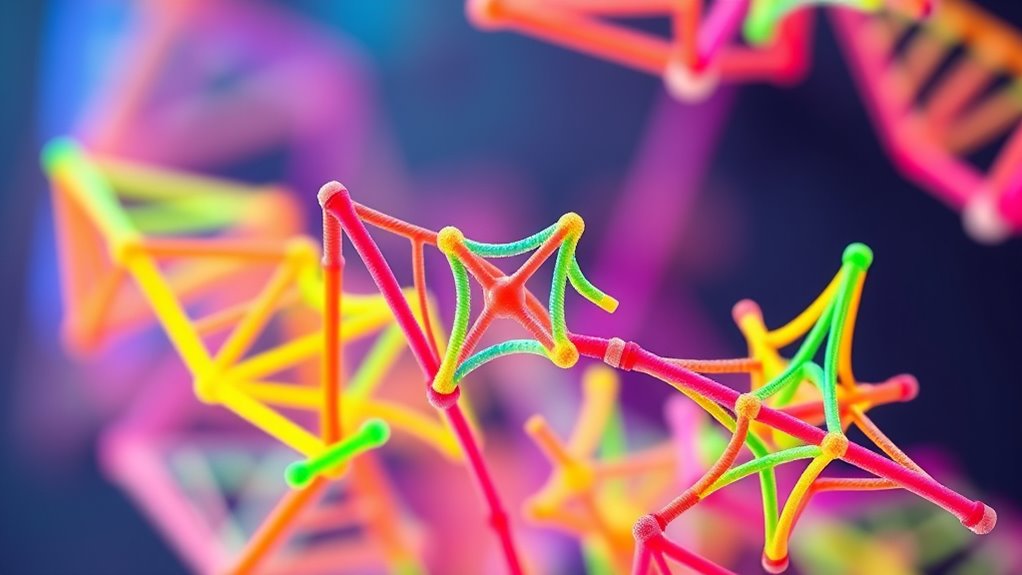
Folding DNA into precise shapes relies on carefully orchestrated techniques that direct the molecule to form specific structures. You use dna folding methods, such as thermal annealing, to control how strands hybridize and achieve the desired configuration. By designing a scaffold strand and numerous short staple strands, you guide the DNA to fold into complex nanostructures. Precise control of temperature and salt concentration guarantees correct hybridization, which enhances nanostructure stability. Techniques like atomic force microscopy verify the accuracy of these shapes. You can also employ computational tools to predict folding pathways and optimize staple placement. These techniques collectively enable you to create highly specific, stable DNA shapes, forming the foundation for advanced nanomachines. Proper dna folding is essential for achieving functional, durable nanostructures. Additionally, understanding the impact of contrast ratio can help in visualizing these intricate nanostructures more clearly under microscopy.
Assembly and Stabilization of DNA-Based Nanomachines
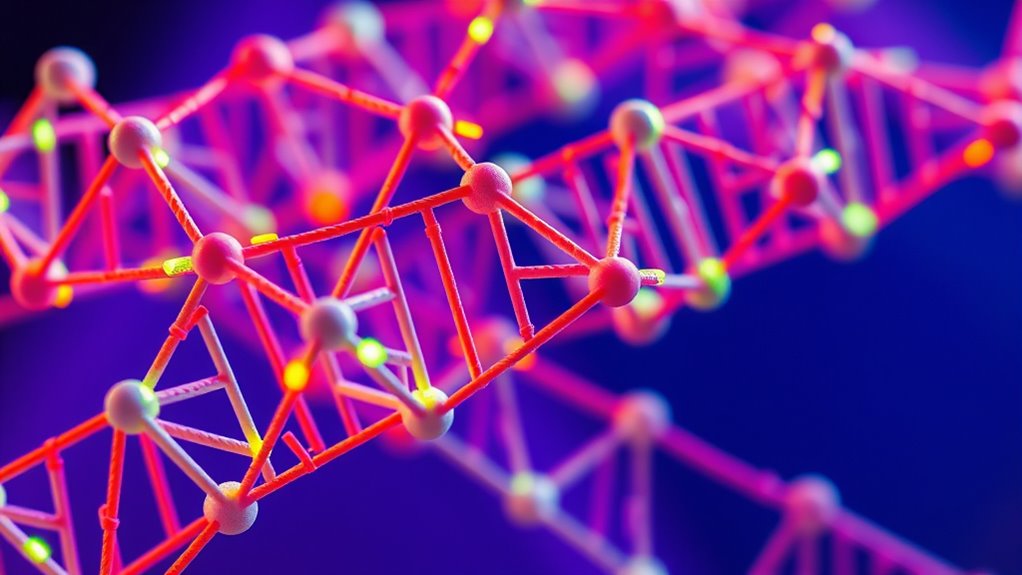
Once you’ve achieved precise DNA shapes through controlled folding, the next step is assembling these structures into functional nanomachines. You do this by carefully designing DNA sequences to ensure proper hybridization, which is vital for reliable assembly. DNA sequence optimization helps minimize unintended interactions and enhances the efficiency of the assembly process. To guarantee your nanomachines operate reliably under various conditions, you also focus on thermal stability. This involves selecting sequences and structural motifs that resist denaturation at higher temperatures. Stabilization techniques, such as crosslinking or incorporating binding staples, further reinforce the structure. Additionally, MobQuotes highlights how powerful words and inspiring quotes can serve as tools for motivation and resilience, which can be metaphorically applied to overcoming challenges in nanomachine design. By combining optimized DNA sequences with strategies for thermal stability, you create robust, functional nanomachines capable of precise tasks and consistent performance.
Applications of DNA Origami in Medicine and Electronics
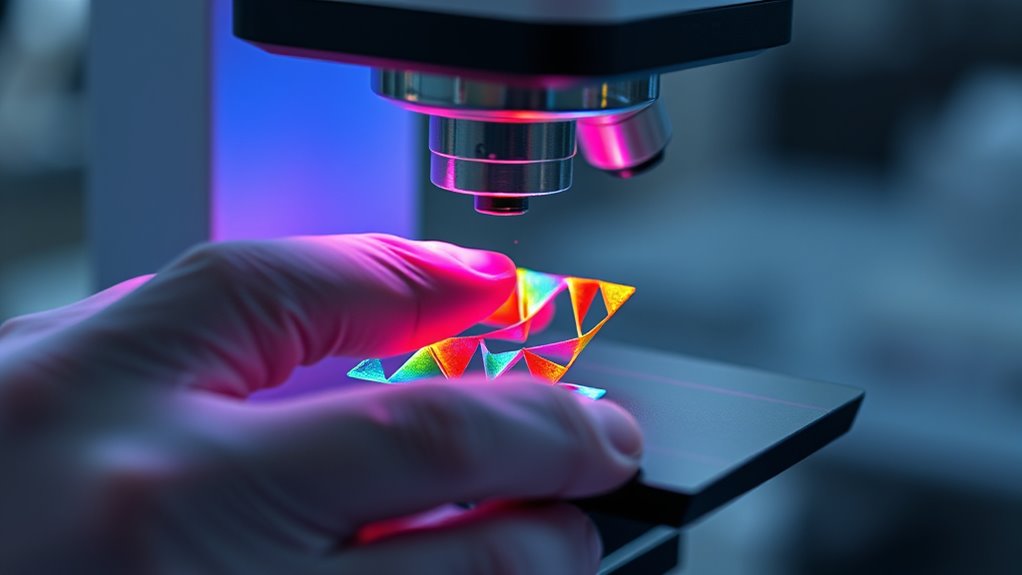
DNA origami is transforming medicine and electronics by enabling precise targeted drug delivery systems and tiny nanoelectronic components. You can harness these structures to improve how drugs reach specific cells or to create faster, smaller circuits. Exploring these applications opens new possibilities for innovation in both fields. Essential oils can also be used in related fields like healthcare for their therapeutic properties, demonstrating the versatility of nanotechnologies and natural compounds alike.
Targeted Drug Delivery
Targeted drug delivery leverages the precise structural control offered by DNA origami to transport therapeutic agents directly to diseased cells. You can design nanostructures that navigate biological pathways, ensuring drugs reach their specific targets while minimizing side effects. DNA origami can also incorporate environmental sensing features, activating only in response to signals like pH or enzyme presence. This enhances delivery accuracy and reduces off-target effects. To illustrate, consider the following:
| Feature | Benefit |
|---|---|
| Biological pathway targeting | Precise delivery to diseased cells |
| Environmental sensing | Activation in specific conditions |
| Structural customization | Tailored nanocarriers |
Nanoelectronic Components
Nanoelectronic components crafted from DNA origami harness the molecule’s ability to form precisely defined and functional nanostructures, opening new avenues in medicine and electronics. These components utilize molecular motors to enable movement and signal transduction at the nanoscale, enhancing device functionality. Structural stability ensures these delicate structures maintain integrity during operation, vital for reliable performance.
You should focus on:
- Designing DNA origami circuits for efficient data transfer.
- Incorporating molecular motors for dynamic nanoscale motion.
- Ensuring structural stability to withstand environmental conditions.
These advancements allow you to develop ultra-compact sensors, transistors, and memory devices that are both adaptable and durable. Using DNA origami for nanoelectronic components promises to revolutionize the way you approach miniaturization and functionality in modern technology.
Challenges and Limitations in Nanoscale Construction
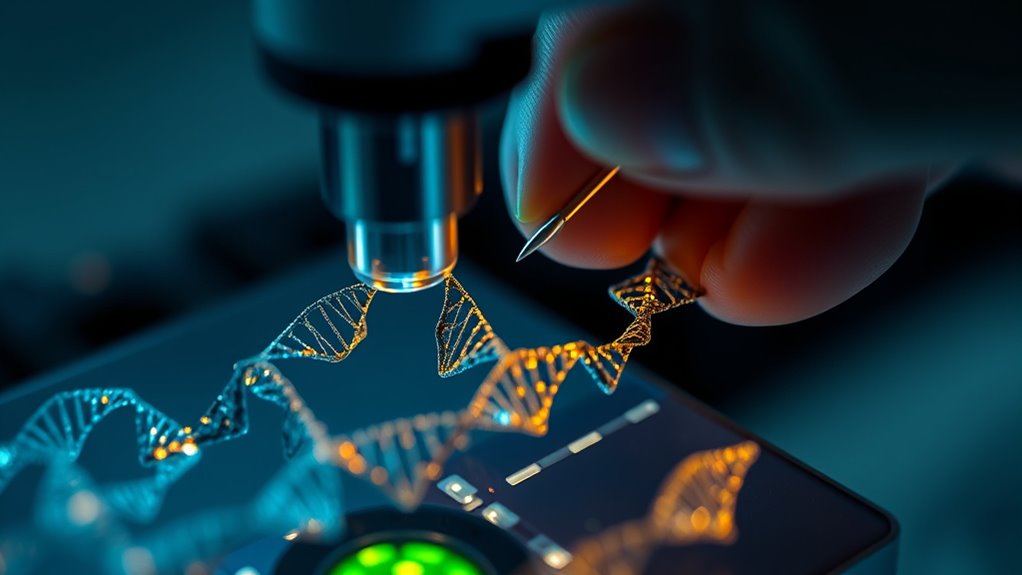
Constructing nanomachines with DNA origami tiles presents several significant challenges that researchers must navigate. Scalability issues hinder mass production, as creating consistent, high-yield assemblies becomes complex at larger scales. Environmental stability also poses a problem; DNA structures are sensitive to conditions like temperature, pH, and nucleases, which can cause degradation or misfolding. Maintaining precise control during assembly is difficult, leading to potential defects or inconsistent functionality. Additionally, integrating DNA origami with other materials or systems often requires sophisticated techniques, further complicating the process. These limitations restrict practical applications and scalability. Overcoming these challenges requires advances in materials, assembly methods, and protective strategies to guarantee reliable, stable nanostructure formation suitable for real-world use. Furthermore, ongoing research into nanomanufacturing techniques aims to address these scalability and stability issues, bringing us closer to viable nanotechnology solutions.
Future Directions and Emerging Innovations in DNA Nanotechnology
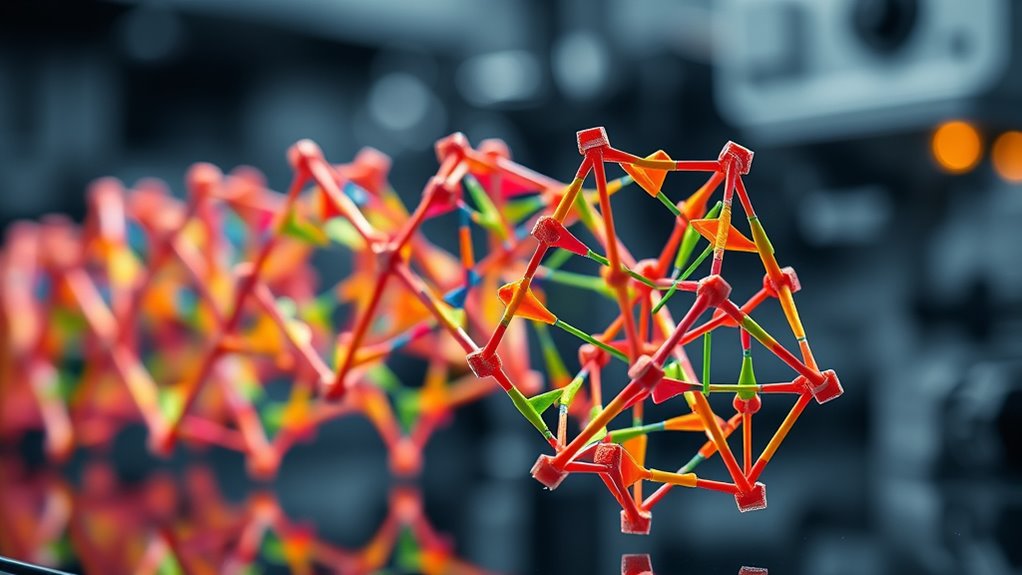
Advances in DNA nanotechnology are paving the way for innovative approaches to overcome current limitations and expand its practical applications. In the future, expect significant progress in areas like synthetic biology, where DNA origami can create programmable biological systems. Environmental sensing will also benefit, enabling nanoscale devices to detect pollutants or toxins with high precision. To stay ahead, focus on these emerging innovations:
DNA nanotech advances enable programmable biological systems and precise environmental sensors for real-world applications.
- Developing dynamic, reconfigurable DNA nanostructures for real-time responses in biosensing and synthetic biology.
- Integrating DNA origami with other nanomaterials to enhance stability and functionality in diverse environments.
- Creating autonomous nanomachines capable of environmental monitoring, targeted drug delivery, or molecular computations.
- Leveraging payment services technologies to facilitate secure and efficient data management and device coordination in nanotechnology networks.
These advancements will unlock new possibilities, transforming nanotechnology into a versatile tool for real-world challenges.
Frequently Asked Questions
How Durable Are DNA Origami Nanomachines Under Operational Conditions?
DNA origami nanomachines are quite durable under operational conditions, thanks to their high molecular stability and design optimizations. You’ll find they can withstand various environmental factors like temperature and ionic strength, though their resilience depends on specific conditions. To maximize durability, you should consider protective coatings or modifications that enhance environmental resilience, ensuring your nanomachines perform reliably in diverse settings.
Can DNA Origami Be Integrated With Other Nanomaterials?
Yes, you can integrate DNA origami with other nanomaterials to create hybrid materials and achieve functional integration. You actively combine DNA structures with nanoparticles, proteins, or carbon-based materials, enabling new capabilities. This integration enhances stability, introduces new functionalities, and broadens application possibilities. You design these combinations carefully, ensuring precise assembly and compatibility, which ultimately leads to innovative nanodevices with tailored properties for diverse scientific and technological uses.
What Are the Costs Associated With Large-Scale DNA Nanostructure Production?
The costs for large-scale DNA nanostructure production mainly depend on cost analysis and manufacturing scalability. You’ll find that expenses decrease as you optimize synthesis methods and increase batch sizes, making mass production more feasible. However, current costs can still be high due to DNA synthesis and purification. To reduce costs, focus on improving automated processes and developing cost-effective materials, which will help scale up production efficiently and economically.
How Do Environmental Factors Affect DNA Nanomachine Functionality?
Environmental factors substantially influence DNA nanomachine functionality by affecting environmental stability and reaction conditions. You need to control temperature, pH, and ionic strength carefully, as fluctuations can cause denaturation or structural instability. Humidity and exposure to nucleases also pose risks. By maintaining ideal reaction conditions and ensuring environmental stability, you can enhance the performance and reliability of your DNA nanomachines in various applications.
Are There Ethical Concerns Related to DNA Nanotechnology Applications?
Yes, there are ethical concerns with DNA nanotechnology applications. You should consider genetic privacy risks, as manipulating DNA could expose sensitive information or lead to misuse. Additionally, the bioethical implications involve potential unintended consequences, such as environmental impact or misuse in biological systems. It is crucial to weigh these concerns carefully to guarantee responsible development and prevent harm, respecting both individual rights and broader societal values.
Conclusion
As you explore the world of DNA origami, envision tiny machines built with exquisite precision, weaving through cells or guiding electrons like delicate bridges of light. You’re shaping molecules into intricate, functional devices that could revolutionize medicine and electronics. Though challenges remain, your innovations are paving the way for a future where these nanomachines quietly perform miracles at the smallest scales—transforming imagination into reality, one carefully folded strand at a time.
